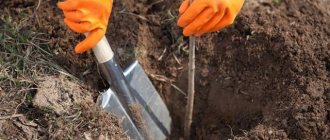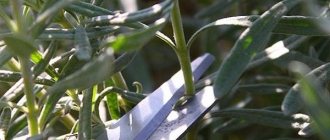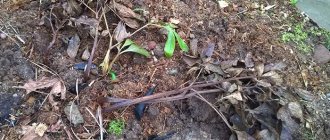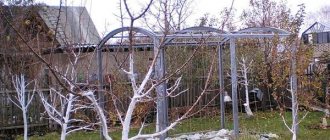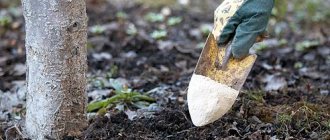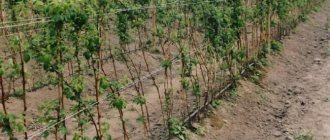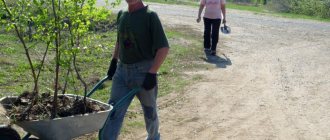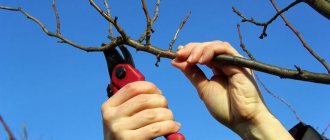Stages of preparing clematis for winter
Clematis are heat-loving vines that bloom in summer. In autumn, with the arrival of cold weather, their life processes slow down. Clematis are preparing for winter hibernation. However, plants cannot do without human help. After all, these vines come from warm climate zones, and in frosty winter conditions they can freeze and die.
Stages of preparation for winter cold:
- pruning according to variety or group;
- processing of stems and soil;
- insulation of shoots.
Depending on the variety or group, plant branches are trimmed by 10-20 centimeters or completely cut off, leaving stumps 20-30 centimeters high at the surface of the ground. Pruning is carried out from October to November.
Having cut off all unnecessary stems, the remaining branches are removed from the support, carefully twisted and laid near the root on the ground on a litter.
If in winter the air temperature drops below 5 degrees below zero, clematis need to be covered from above. Plants from which all shoots are completely cut off are also insulated before the onset of winter cold.
Before covering clematis, bushes and the ground around them, it is advisable to treat them with a solution of Fundazol (20 grams per 10 liters of water). The stem itself must be sprinkled high with soil mixed with sand, peat and wood ash. Then the clematis is insulated with mulch and waterproof material.
Removing thermal insulation
You can start removing cover from bushes when the warm season returns, even if there is a risk of a return of night frosts. The real problem for the plant is excessive moisture or unexpected thaws. Such phenomena cause damping off of the sprouts due to the lack of fresh air. In most cases, the insulating layer is removed in April, but not all at once, but a small part, continuing the opening procedure until May. Clematis must gradually adapt to new conditions and begin active recovery after winter.
The process of removing the cover occurs in several stages, which are divided by days. The first step is to open the ventilation holes, making sure that the air temperature is consistently comfortable. You can remove the polyethylene and the upper part of the insulation after the arrival of stable heat, when the risk of night frosts or snowfall is completely eliminated.
But don’t rush to remove the hilling layer. The plant must undergo full adaptation to the new environment and only after a couple of days can the mound be removed. The remaining soil is removed only after the threat of repeated frosts has passed. Often in the spring, a gardener discovers that the flower was unable to survive the winter and has disappeared. But this does not mean that you need to dig up the root as quickly as possible, since it is quite possible that in a few years it will recover and produce healthy shoots. This can be facilitated by the activation of dormant kidneys.
If clematis shows no signs of life during the summer season, it must be reliably insulated in winter. With the arrival of spring warmth, it can sprout. Some gardeners replant clematis after removing the cover in the spring to a new location. It should be sunny and protected from shade with fertile soil.
Before planting the plant in new soil, you need to deeply loosen it. This measure is necessary for good drainage, which will be a good stimulation of productive growth and development of the crop. It is imperative to install trellises that will act as a support for the rapidly growing vine.
Pruning clematis for the winter depending on the group
Plants are divided into 3 groups. Each type of clematis needs pruning before wintering. The branches need to be trimmed correctly. After all, the full development of vines and abundant flowering in the next season depend on this.
Pruning can be sanitary, formative and winter. Sanitation is the removal of dry and diseased branches from a healthy main stem. Formative - pruning excess shoots in order to improve development and prolong flowering. Winter pruning is carried out in order to prepare clematis for winter and protect it from frost.
In September, they begin to slowly remove dried leaves from the stems, since they do not fall off on their own. After removing the leaves, the clematis branches are trimmed. Pruning is carried out at the end of October and beginning of November, in dry, windless weather.
Pruning clematis of the first group for the winter
Clematis of this variety bloom only on the shoots of the previous year. Minimal pruning is recommended for them. The upper branches of the vine are slightly shortened by 20 centimeters. The length of the stems is adjusted depending on the support to which they are attached. It is important to preserve old shoots, because they will bloom next season. When pruning for the winter, remove weak and dried stems.
Pruning clematis of the second group for the winter
Clematis of this species bloom on old shoots at the beginning of summer, and on young shoots in late summer. Medium pruning is recommended for them. Old branches are slightly shortened at a distance of 150 centimeters from the ground, young branches are not touched at all. More intensive pruning, aimed at rejuvenating the plant, is carried out every 5 years.
If the bush is only one year old, then before winter its stem, which has grown over the summer, is greatly shortened, leaving a stem 30 centimeters long above the surface of the ground.
Pruning clematis of the third group for the winter
Clematis of this group bloom at the very end of summer, on young branches that have grown in the current season. Before wintering, all stems of the plant are completely cut off. Only low stems (30 centimeters above the ground) with three pairs of buds are left.
Universal pruning of clematis
If gardeners cannot determine which group their clematis belong to, universal pruning is recommended. In the first year of life, all types of vines are pruned in the same way - the grown stems are completely cut off, leaving shoots 30 centimeters long with a pair of buds on them. If you remove young branches from a plant in its first year of life, it will subsequently grow stronger. Clematis will begin to bush and develop side stems.
See also
Description of clematis variety Blue Angel, planting and care rulesRead
How to perform universal pruning:
- all stems are divided into 3 parts;
- the first part is cut at a distance of 30 centimeters from the ground;
- the second part is cut so that stems 1 meter long remain;
- the third part is not touched, only slightly shortened on top (by 10-20 centimeters).
In the new season, with the beginning of plant growth and development, you need to see which part will grow better and then bloom. It is recommended to carry out the next autumn pruning, taking into account the flowering results of stems trimmed in different ways. Bushes can be pruned to varying lengths from time to time. In this way, the plant will gradually rejuvenate.
Young plants
In addition to caring for old plants, every gardener should know how to prepare clematis for winter, which is 1-2 years old. To preserve the crop from freezing in the open ground, you need to observe the following measures:
- With the arrival of autumn, the vines are cut off, and only 3-4 buds are left on the shoots. Moreover, the intensity of pruning remains the same for all varieties and methods of forming peduncles.
- The bush is covered with branches, as well as polyethylene, which will protect it from excess moisture. Before this, a mound of earth is poured over it.
- A small young clematis is covered with a large flower pot, on top of which spruce branches, wood shavings or sawdust are placed.
As for the specific care of clematis during the winter cold, it will not be needed with proper and timely shelter. However, if the temperature drops to critically low levels and there is no snow, you will have to cover the bushes with any insulating material, preferably spruce branches or hay.
We also cannot exclude the possibility of small rodents, usually mice, appearing under cover. If traces of their vital activity appear near clematis, it is necessary to scatter seedlings nearby or install mousetraps. Otherwise, rodents will destroy healthy flower sprouts.
Features of clematis shelter
Plants are covered in early November. Shelter is carried out only after pruning and processing. Branches, spruce branches, bark, sawdust, and artificial waterproof materials are used for shelter. You can pour a little earth or snow on top of the insulation.
The insulating structure should be light so that the plant branches under it do not break. Clematis needs to be provided with air access, otherwise its stems will get wet and dry out. To do this, small holes are left on the sides of the shelter for ventilation.
First years
In the first year, the stems are completely cut off, leaving stumps (with buds) 30 centimeters high near the ground. Such sprouts are buried high in soil mixed with sand, peat, sawdust and wood ash. The top of the low mound can be covered with agrofibre, lutrasil or roofing felt.
young bush
Young stems are spud high, bent to the ground, laid on dry spruce branches and wrapped on top with agrofibre. Lutrasil or roofing felt can be used as insulation. A wooden box can be placed on top of the plant.
White clematis
Lianas that bloom on the shoots of the past and new year are usually removed from the support and slightly twisted. The stems are laid on a support made of wooden blocks. They are covered with dry sawdust or spruce branches on top. Then - roofing felt or lutrasil.
Small-flowered
If adult vines are left on a support, then at the base their stem is mounded high with earth. The plant itself is wrapped several times with agrofibre. This material allows air to pass through perfectly and prevents the plant from drying out.
Manchurian
All stems of this variety of clematis are removed before wintering, leaving stumps up to 20-30 centimeters high near the ground. Before the onset of frost, plants are completely sprinkled with a light earthen mixture (sand, peat, sawdust) and covered with roofing felt.
Clematis description
Clematis is a true leader in vertical gardening. Clematis can grow in one place for more than 20 years. Clematis is convenient because it produces a maximum of flowers in a small area - one plant replaces an entire garden. This perennial does not require much care and takes root well.
The clematis plant or clematis belongs to the Buttercup family. Homeland - Europe, Asia, North and South America, Africa, Australia These are perennial herbaceous vines with woody stems and flexible shoots. The height to which clematis grows exceeds 3 m. This is how they manage to grow over the summer. Bush forms of climbing clematis plants do not exceed 1.5 m in height. Liana-shaped clematis climb onto supports, clinging to them with leaf petioles….
The leaves are simple or compound, trifoliate or odd-pinnate, ovate, lanceolate or linear-lanceolate, on average 4-5 cm long, up to 10 cm. The flowers are collected in inflorescences, less often solitary. Flower color ranges from white and yellow to purple, blue, carmine red, with many shades. Clematis differ in flower size. There are species and varieties with flowers up to 10 - 20 cm in diameter and small-flowered ones, from 2 to 4 cm. When writing clematis flowers, it is necessary to note that some species have a delicate, very pleasant aroma. Now this crop is grown in Siberia, the Far East and even in the North. Clematis are divided into 2 main groups: small-flowered clematis with a flower size from 2 to 5 cm and large-flowered clematis with a flower size up to 15 cm. Small-flowered clematis species are less known in floriculture, although they are very decorative and at the same time unpretentious, more winter-hardy and drought-resistant than grandiflora.
How to prepare a clematis planting site for wintering
Before winter, bushes need to be treated with fungicides and sprinkled with soil with the addition of wood ash. This treatment will protect clematis from fungal diseases.
Soil cultivation in the tree trunk circle
The soil around the clematis is treated with Fundazol. In open ground there are many fungi and other microorganisms dangerous to plants. To destroy them, the soil within a radius of 50 centimeters from the stem is watered with a disinfectant solution.
Soil disinfection
To treat the soil and stems, not only fungicides are used, but also copper-containing preparations (copper sulfate). It is advisable to use the following agents for soil disinfection: Fitosporin M, Fitop Flora S, Fundazol.
Soil hilling
The soil around the stem is loosened, a bucket of peat and sand, 200 grams of wood ash are added and the stem is sprinkled with this mixture. If the shoots rise 30 centimeters above the surface, then they are completely covered with soil mixture.
For hilling, you can mix a little rotted humus into the ground. The organic additive will not only protect the plant roots from freezing, but also provide them with nutrients. Hilling is carried out to a height of 30-40 centimeters.
How to choose a clematis seedling for autumn planting
For autumn planting, it is recommended to choose exclusively zoned seedlings , that is, suitable for growing specifically in your climate zone.
You should buy clematis seedlings exclusively from trusted and reliable nurseries or garden centers that enjoy a good reputation and have positive reviews from real customers. If you try to buy planting material in an unverified place (on the market, at an unauthorized point of sale), then there is a high probability of stumbling upon a low-quality product.
Note! When purchasing a seedling, be sure to remember which pruning group the clematis belongs to - group 1, 2 or 3. This information is very important for proper care and pruning of the perennial plant.
Clematis planting material can be found in two types:
- One-year-old seedlings with a closed root system (ZKS) . They are often sold in pots that are protected in a cardboard box. The photo illustrates the planting material of ZKS in polka dots:
- Annual rooted shoots with an open root system (ROS) . They are usually sold in a bag, in peat soil. The photo shows specimens with OKS, but without primer:
Advice! It is recommended to buy clematis seedlings with a closed root system (ZKS). There are a number of reasons for this:
- they are better stored until planting;
- take root faster and more successfully in open ground in a new place;
- planting them is much easier (no need to straighten the roots, control their position in the planting hole, etc.).
However, planting material with ZKS is slightly more expensive than rooted shoots with an open root system.
Treating plants against pests
To control pests, the base of the stems can be painted with a lime solution before wintering. For five liters of water take 0.5 kilograms of quicklime. As a preventive measure against pests, clematis can be sprayed with a solution of Bordeaux mixture. The same preparation is used to irrigate the soil near the stem.
To combat rodents, baits and mechanical traps are installed near the vines, and the base of the stem is sprinkled with pepper.
How to unhook vines from a support
The branches of the plant must be carefully removed from the support before winter. To do this, first, all dry leaves are removed from the stems, then the plants are untied from the support, and the shoots tangled behind the fence are cut off. By unhooking the clematis from the support, you can at the same time prune the plant. During the removal process, the branches are shortened slightly, leaving a stem at least 1.5 meters long.
To make it easier to care for clematis in the fall, it is advisable to tie it to a support on only one side in the spring.
With this method, the branches are not intertwined around the pipe, but only tied to it with ropes.
Transplanting clematis: when is the best time to carry out the procedure?
If you do not have experience in growing clematis, the question may be relevant to you regarding its transplantation. It is recommended to do this at the end of summer or early September. The best time in spring is late April or early May.
Related article:
Feeding clematis
Place seedlings at a distance of 1 m
It is important to have time to replant clematis in the fall before the first frost. If the procedure is not carried out on time, there is a risk that the seedling will not take root and will die. As a rule, clematis is transplanted to a new place if the previous one is not suitable for it. The liana is also replanted if it gets old.
If there is a need for this due to illness, the new place will need to be treated with Trichoflor solution (5 g per 10 liters of water). When all work related to planting is completed, mulch the soil with wood ash.
If you decide to replant clematis in the fall, you need to carry out a number of additional manipulations. First, cut it off, and then dig around the bush with 1-2 shovels. Remove along with the earthen lump. Shake off excess soil and divide them into sections of 4-6 stems. For this procedure you will need a garden saw or hatchet. Use pruning shears to shorten the roots. Make sure that the roots are not dry during transplantation. Once you finish it, water the plant.
Related article:
We make supports for clematis with our own hands
Keep in mind that replanting adult clematis, no matter what pruning group it belongs to, can be done without dividing. If the plant is more than 6-7 years old, division will be inevitable. By this period, the roots become strong and long, so cutting them will not be so easy. Take your time, otherwise you risk damaging the root system.
Methods for insulating plants for the winter
Before wintering, it is advisable to insulate the bushes so that they do not freeze or dry out. These vines are afraid of frost and excess moisture. The shelter for the winter should provide access to air, be warm, dry and not get wet.
See also
Description and characteristics of mountain clematis, planting and careRead
Hilling
Clematis, which are completely cut off before wintering, leaving only low stumps, are covered with earth mixed with peat and sand. You need to make a high mound above the stems (from 30 to 60 centimeters).
Combined shelter
Completely cut plant stems can be insulated not only by hilling, but also covered on top with agrofibre or roofing felt. You can sprinkle the earthen mound with sawdust, dry branches, or place a wooden box over it.
Air method of shelter
Clematis, which blooms on last year's branches, is covered by air. The plant is covered with earth, then removed from the support and rolled up. Dry twigs or spruce branches are placed underneath.
Metal or wooden arcs are installed on top of the vine, onto which roofing material or agrofibre is pulled.
You can cover the plant with a wooden box and sprinkle spruce branches on top. This structure is covered from above with roofing felt or agrofibre, leaving holes on the sides for ventilation. The main thing in this method of shelter is to leave air space between the branches and the protective insulation.
Covering individual bushes
In order to preserve clematis in winter, individual bushes can be bent to the ground, laid on wooden slats or dry branches, and covered with a box or roofing felt on top. It is necessary to make holes for air ventilation.
Clematis group shelter
Lianas growing in a row can be insulated as a group. To do this, they are removed from the support, bent to the ground, laid on dry branches or spruce branches, and metal arcs are placed on top, onto which roofing felt or agrofibre is pulled.
Enhanced insulation
To prepare for a harsh winter, vines need to be thoroughly insulated. The plants are removed from the support and placed on a thick layer of spruce branches or dry sawdust. Metal arcs are installed on top, agrofibre is stretched, another layer of spruce branches is laid on top and again covered with roofing felt. You can build a wooden structure on top of the shelter.
Varietal features
The need for pruning depends on the timing of flowering, as well as on the varietal characteristics of the clematis. Winter care, including pruning procedures, is carried out according to the following principles:
- Plants that bloom only on the current year's shoots require comprehensive autumn pruning. These include the varieties Jacqueman, Viticella and Integrifolia.
- Clematis, which bloom on last year's shoots, do not lend themselves to formative pruning, but are only cleared of dead, diseased or rotten branches. When processing such a crop, you need to leave shoots and flower buds for the next season. Among these plants are vigorous varieties, as well as various forms of mountain, alpine and golden clematis.
- Varieties that bloom twice a season are pruned slightly. However, such a procedure is mandatory when preparing for wintering. Representatives of the Lanuginosa and Florida groups are amenable to pruning.
But gardeners have differing opinions regarding pruning the second and third types of plants. On the one hand, there are exceptions among different groups of clematis, and on the other, most varieties that supposedly bloom only on last year’s shoots are capable of blooming on both young and overwintered branches.
In any case, all varieties require regular sanitation and cleaning of dead, diseased or wilting shoots. Regardless of the type of flowering and autumn formative work, all bushes are amenable to the following procedures:
- Removing and harvesting all dry leaves, followed by destruction away from the vine.
- Removing dry shoots.
- Removing damaged branches that show signs of serious disease, as well as weak or low-productive shoots.
The specifics of pruning varieties that bloom on the shoots of the current year differ in different principles. For example, representatives of the Vititsela or Jacqueman group are cut off to almost the entire length of the aerial part. The gardener needs to leave only short stumps, just above the soil level.
How to treat clematis for the winter
Before wintering, the stems need to be treated to protect them from pests. Copper sulfate is considered the most affordable drug. For processing, prepare a solution: 50 grams of the substance are diluted in 5 liters of water. Immediately after preparation, the bush is sprayed with this product. The vines are processed in dry, windless weather. This product will protect clematis from developing mold in winter.
Treatment with iron sulfate will protect the vine from fungal microorganisms. This product will additionally feed the bushes with microelements of iron. For spraying, prepare a solution: 30 grams of iron sulfate are dissolved in 10 liters of water. The stems of the plant are irrigated with the liquid, a little of the mixture is poured under the root.
Clematis - care in open ground in late summer and autumn
Clematis require regular care, which consists of watering, loosening the soil, weeding and fertilizing. The vine is also pruned, protected from pests and diseases, and covered for the winter so that the plant does not die. We will talk about some stages of care in more detail in other paragraphs, but here we will touch on watering, fertilizing and protection.
Watering. In autumn, watering is reduced. If there is no precipitation, it is enough to water the plants once every 1.5-2 weeks, using a bucket under the bush. In case of rainy weather, the vine will have enough natural precipitation. Too much waterlogging of the soil can lead to the death of clematis in winter, so carefully monitor the condition of the soil.
Feeding clematis in August. During this period, plants need phosphorus and potassium, so add 0.5 tbsp under each bush. superphosphate and potassium sulfate.
Feeding clematis in the fall. If at the end of summer you did not add phosphorus and potassium to the plants, have time to do this before mid-September. Then stop feeding. At the end of the month, you can sprinkle the soil with wood ash to prevent rotting of the roots and wilting of the shoots.
Nitrogen fertilizer for clematis is strictly contraindicated during this period.
Treatment for diseases. If the plants are healthy, winter treatment may not be necessary. If there are signs of disease after leaf fall, spray the shoots and trunk circle with 3% Bordeaux mixture.
Also, one of the important care measures is pruning clematis after flowering.
Caring for clematis in winter
In winter, it is advisable to constantly monitor how covered plants behave. If icing appears on the branches, they additionally need to be wrapped in a layer of warm reeds or straw, and wrapped several times with agrofibre on top.
If the plant sweats, on the contrary, you need to remove the excess layer of cover, ventilate the stem, and wrap it with breathable material. In winter, you can pour more snow on the structure, under it the plant will be warmer. During the thaw, you need to make sure that moisture does not accumulate near the stem, otherwise the clematis will dry out and rot.
Different regions and shelter of clematis
Each region has its own way of covering plants. In the southern latitudes, the bushes are only covered high with earth, but in the northern regions they are insulated with sawdust, spruce branches, roofing felt, or wooden protective structures are made on top.
In the Moscow region and the Middle Zone
In the Moscow region, clematis are insulated by hilling and covered with agrofibre or roofing felt on top. If the plants are removed from the support, it is laid on dry branches or spruce branches. Then a box or metal arcs are installed on top, onto which agrofibre, lutrasil, film or roofing felt are stretched.
In the Volga region
In the Volga region, when insulating clematis for the winter, they make sure that they are not flooded with water. To do this, special grooves are made to drain water, and high wooden slats are placed on the ground, on which the stems removed from the support are laid. Then the plant branches are covered with roofing felt or lutrasil.
In the Leningrad region
Clematis are removed from the support, placed on wooden slats, and then covered with agrofibre or roofing felt. You can insulate clematis with spruce branches and cover the top with a wooden box wrapped in film.
In the Urals and Siberia
In regions with cold frosty winters, clematis are thoroughly insulated. The plants are laid on spruce branches or sprinkled with sawdust, wrapped in agrofibre, and wooden structures are installed on top. They are also wrapped in film. Then the shelter is covered with a thick layer of snow.
Useful tips
In the spring, clematis needs to be provided with balanced care, which will allow it to quickly restore strength after a long winter, start metabolic processes and begin to form new shoots. In spring, the crop needs to be watered abundantly and also fed with all kinds of mineral or organic fertilizers. They must contain a lot of nitrogen, potassium and phosphorus, as this is necessary for gaining green mass and rapid growth.
Clematis are the most beautiful garden flowers that surprise gardeners with their unsurpassed beauty and long-term flowering. But, like other representatives of exotic flora, they are a rather capricious plant with high requirements for living conditions. Therefore, before you buy seedlings and plant them in private gardening, you need to make sure of their winter hardiness and ability to grow in the conditions of the middle zone. Varieties such as Leningradsky, Cardinal and Clematis Beata are excellent for such terrain.
To grow healthy and beautiful clematis in the garden, you need to properly care for them, as well as do all the procedures regarding pruning, storing in winter, opening in spring, and so on. In this case, the liana will thank the grower with unrivaled flowering and good health.
